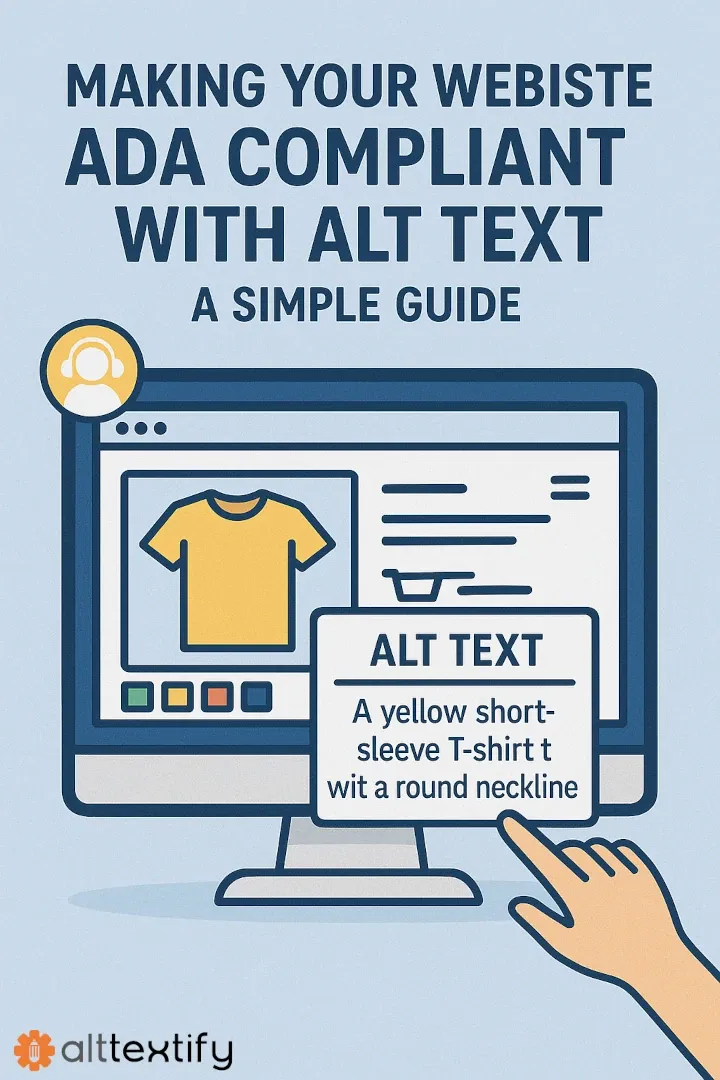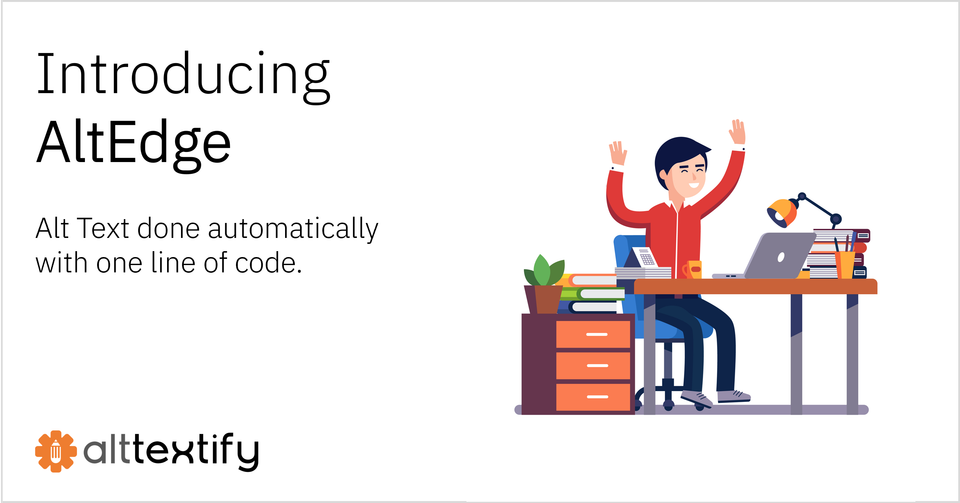Making Your Website ADA Compliant with Alt Text: A Simple Guide
Your website needs to work for everyone. That includes people who can't see images or have trouble viewing them. This is where ADA compliance comes in, and alt text is a big part of it.

Your website needs to work for everyone. That includes people who can't see images or have trouble viewing them. This is where ADA compliance comes in, and alt text is a big part of it.
The Americans with Disabilities Act (ADA) requires businesses to make their services accessible to people with disabilities. For websites, this means people using screen readers or other assistive tools should be able to use your site just like everyone else.
Alt text is one of the easiest ways to make your website more accessible and avoid legal problems.
What Is ADA Compliance?
ADA compliance means your website can be used by people with disabilities. This includes people who:
- Are blind or have low vision
- Use screen readers to navigate websites
- Have slow internet connections where images don't load
- Use keyboards instead of a mouse
When someone uses a screen reader, it reads the alt text out loud instead of showing the image. Without alt text, they miss important information.
Why ADA Compliance Matters
Legal Protection: Thousands of businesses get sued each year for having websites that aren't accessible. Having proper alt text helps protect you.
Bigger Audience: About 26% of adults in the US have some type of disability. Making your site accessible means more people can use it and buy from you.
Better User Experience: Good alt text helps everyone, not just people with disabilities. It makes your site work better when images don't load or internet is slow.
Search Engine Benefits: Search engines use alt text to understand your images, which can help your site rank better.
The Legal Reality
ADA lawsuits against websites are increasing every year. Common problems that lead to lawsuits include:
- Images without alt text
- Alt text that doesn't describe the image properly
- Decorative images that have unnecessary alt text
- Important information only shown in images without text alternatives
The good news? Most of these problems are easy to fix with proper alt text.
How to Write ADA-Compliant Alt Text
Be Descriptive and Clear
Your alt text should paint a picture for someone who can't see the image.
Good: "Red stop sign on metal pole against blue sky"
Bad: "Sign"
Keep It Concise
Screen readers read alt text out loud. Long descriptions can be annoying. Aim for one or two sentences.
Good: "Woman in business suit shaking hands with client"
Bad: "Professional businesswoman wearing a navy blue suit and white shirt extending her hand in a friendly handshake gesture with a male client in a gray suit in what appears to be a modern office setting"
Include Important Text
If there's text in your image that's important to understand your content, include it in the alt text.
Image: Screenshot of error message
Alt text: "Error message reading 'Please enter a valid email address'"
Skip Decorative Images
Images that are just for decoration don't need descriptive alt text. Use empty alt text (alt="") so screen readers skip them.
Decorative border: alt=""
Important product photo: alt="Blue running shoes with white soles"
Common Alt Text Mistakes That Hurt ADA Compliance
⚠️ Common Alt Text Mistakes to Avoid
-
No Alt Text: Leaving out
altattributes completely makes images invisible to screen readers. - Useless Alt Text: Generic phrases like "image" or "photo" don't help anyone.
- Redundant Alt Text: Don't repeat information that's already in nearby text.
- Missing Context: Alt text should make sense with the surrounding content.
- Wrong Information: Alt text that doesn't match the actual image confuses users.
Different Types of Images Need Different Approaches
Product Images
Focus on details that help someone understand what you're selling:
"Black leather wallet with 6 card slots, open view"
Charts and Graphs
Describe the main point of the data:
"Bar chart showing 40% increase in sales from 2022 to 2023"
Screenshots
Explain what the screenshot shows:
"Mobile app login screen with username and password fields"
People in Photos
Include relevant details about what they're doing:
"Doctor examining patient with stethoscope"
Logos
Usually just the company name:
"Microsoft logo"
Tools to Help with ADA Compliance
Automated Checking Tools
- WAVE: Free tool that checks for accessibility issues
- axe DevTools: Browser extension that finds accessibility problems
- Lighthouse: Google's tool includes accessibility audits
Alt Text Generation Tools
How AltTextify.net Can Help Your Website Stay Accessible
- AI-Powered Alt Text: Instantly generate accurate image descriptions using advanced AI—no manual typing needed.
- Consistent & Compliant: Ensures every alt text meets WCAG 2.1 and ADA standards for accessibility.
- Scalable for Growth: Perfect for blogs or e-commerce sites with hundreds or thousands of images.
- Compliance Monitoring: Tracks your site's alt text coverage and flags missing descriptions.
- Simple to Use: Built for everyone—no coding skills required.
Manual Testing
The best way to test alt text is to use it yourself:
- Turn off images in your browser
- Use a screen reader to navigate your site
- Ask someone with a visual impairment to test your site
Building ADA Compliance into Your Process
For New Content
- Write alt text as you add images
- Train your content team on accessibility best practices
- Include accessibility requirements in your style guide
For Existing Content
- Start with your most important pages
- Focus on images that contain important information
- Use tools to find images missing alt text
Quality Control
- Review alt text during content updates
- Test with screen readers regularly
- Get feedback from users with disabilities
Beyond Alt Text: Other ADA Requirements
Alt text is important, but ADA compliance includes other things too:
- Proper heading structure (H1, H2, H3)
- Good color contrast
- Keyboard navigation support
- Captions for videos
- Clear link text
The Business Case for Accessibility
Risk Reduction: Proper alt text helps protect against ADA lawsuits.
Market Expansion: Accessible websites reach more customers.
Better SEO: Search engines reward accessible websites.
Brand Reputation: Companies known for accessibility build customer loyalty.
Future proofing: Accessibility requirements are getting stricter, not looser.
Getting Started Today
- Audit Your Current Site: Use free tools to find images without alt text
- Fix High-Priority Pages: Start with your homepage, product pages, and key landing pages
- Create Guidelines: Write rules for your team about alt text
- Train Your Team: Make sure everyone knows how to write good alt text
- Test Regularly: Use screen readers to check your work
Common Questions About ADA and Alt Text
Q: Do all images need alt text? A: No. Decorative images can have empty alt text (alt=""). Only meaningful images need descriptions.
Q: How long should alt text be? A: Usually 10-15 words. If you need more detail, consider adding a longer description near the image.
Q: Can I use the same alt text for similar images? A: Only if the images are truly identical. Different images should have different alt text.
Q: What happens if I don't make my site accessible? A: You could face lawsuits, lose customers, and miss out on business opportunities.
The Bottom Line
Making your website ADA compliant isn't just about avoiding lawsuits. It's about creating a better experience for everyone who visits your site.
Alt text is one of the easiest and most effective ways to improve accessibility. It takes just a few seconds to write, but it can make your website usable for millions more people.
Start small, be consistent, and remember that good alt text helps everyone - not just people with disabilities. Your users, your business, and your legal team will all thank you for it.
Boost Website Accessibility in Minutes
Start using AltTextify.net to automatically generate compliant alt text and meet ADA, AODA, EAA, CAG 2.1, and Section 508 standards.
Try Now



